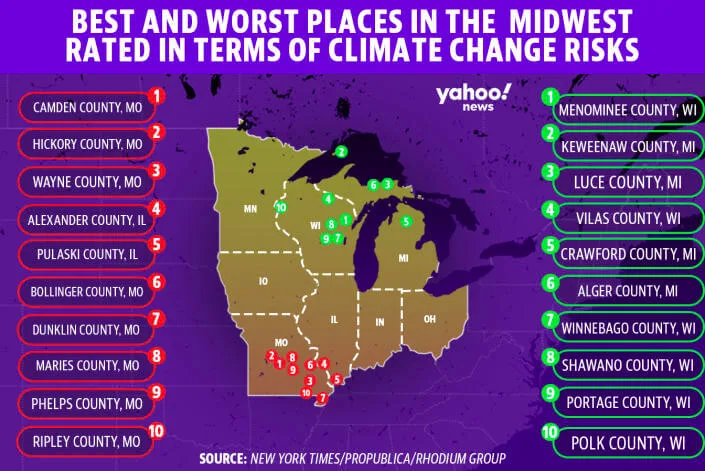
In the 1980s, a weather disaster costing $1 billion in damages hit the US once every four months. Today, they happen every three weeks, according to the latest National Climate Assessment.
While no county is immune to the impacts of climate change, some are certainly more “climate-safe” than others. And in the Midwest, a region well-versed in weather extremes, Wisconsin is a notable bright spot.
The New York Times and ProPublica analyzed a variety of factors, including latitude, elevation, infrastructure, and long-term climate patterns, across counties in eight states (Ohio, Michigan, Indiana, Illinois, Missouri, Iowa, Minnesota, and Wisconsin) to determine their climate change risks.
TL;DR Researchers found the best and worst places to live in the Midwest.
Here’s what they found:
Six of the 10 safest counties to live in terms of climate change risks are in Wisconsin: Menominee, Vilas, Winnebago, Shawn, Portage, and Polk. The remaining four are in Michigan: Keweenaw, Luce, Crawford, and Alger.
Northern counties offer better protection from heat stress, humidity, wildfires, crop loss, and overall climate-created economic damages. But even northern midwestern counties that historically have not been as hot can expect dramatic shifts in temperature if emissions continue at their current pace.
As temperatures continue to rise, the Midwest will also deal with poor air quality. Increases in this are associated with higher rates of lung and cardiovascular diseases, which can lead to hospitalization and premature death.
The worst places to live in terms of climate change are in southern Missouri and southern Illinois. Missouri’s Camden, Hickory, Wayne, Bollinger, Dunklin, Maries, Phelps, and Ripley counties, as well as Illinois’ Alexander and Pulaski, ranked lowest in terms of climate change protection.
Mental health problems are an often-overlooked consequence of climate change. The CDC warns that an increase in droughts, flash floods, and diminished air quality can cause mental health problems like anxiety.
The GOOD News: Small, simple changes add up! There are easy switches we can all make today to help reduce the effects of climate change and slow its impact.
Click here to learn what you can do.
RELATED: Wisconsin Winters are the 5th ‘Most Miserable’ in America

Politics

‘Radical’ Republican proposals threaten bipartisan farm bill, USDA Secretary says
In an appearance before the North American Agricultural Journalists last week, United States Department of Agriculture (USDA) Secretary Tom Vilsack...

New Biden rule protects privacy of women seeking abortions
Under the new rules, state officials and law enforcement cannot obtain medical records related to lawful reproductive health care with the goal of...
Local News

Readers Poll: Top Bowling Alleys in Wisconsin
Looking for the best bowling in Wisconsin? Look no further! Our readers have spoken in our recent poll, and we have the inside scoop on the top...

8 Wisconsin restaurants Top Chef judges are raving about
Top Chef’s 21st season is all about Wisconsin, and on-screen, it’s already apparent that the judges feel right at home here. But, while filming in...





